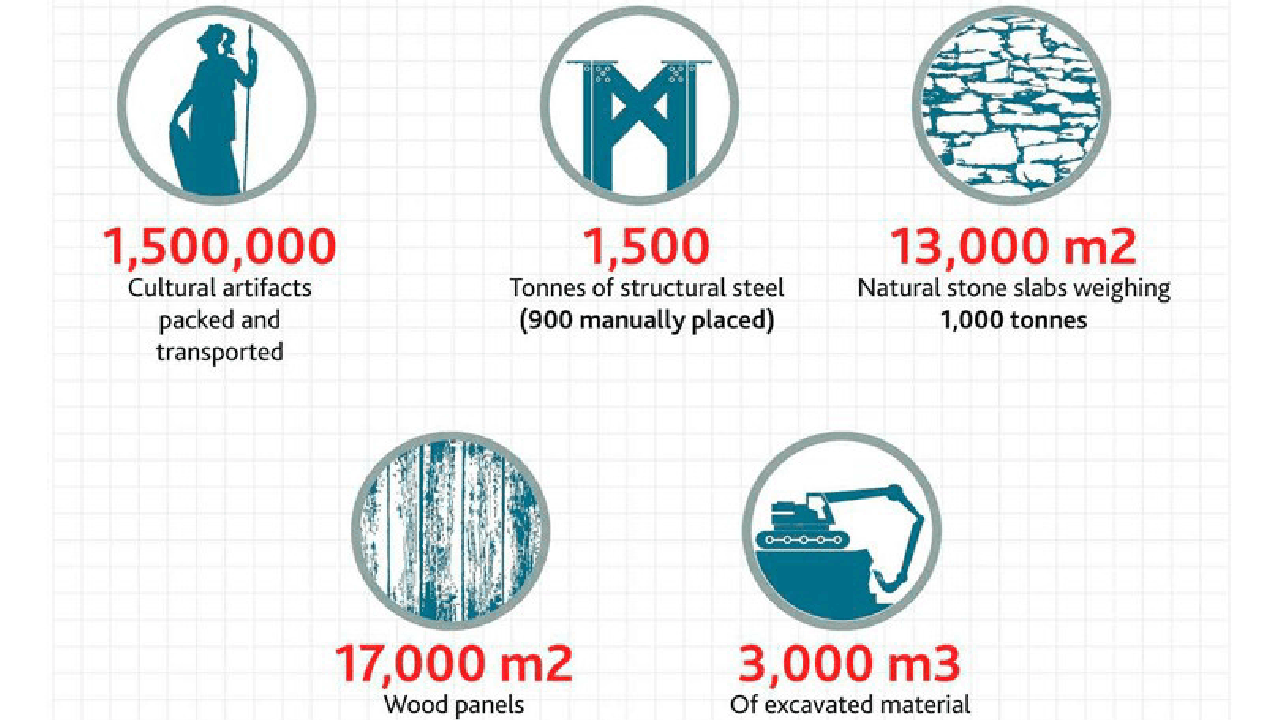The first thing you notice when entering the remodeled National Archaeological Museum (MAN, for its acronym in Spanish) is the light. A permanent brilliance inundates the enormous hall, with every detail bathed in bright light, right into the corners. Once the eyes have got used to this agreeable sensation of brightness, within a few seconds one becomes aware of the harmonious coexistence of polished steel, natural stone and precious wood making up the interior. The smell, feel and conspicuous silence have the effect of inhibiting even our breathing, as we strive to disturb the eternal rest of the history contained between these walls.
What has happened? Just a minute ago, one is immersed in the noise of Madrid’s bustling Serrano street, one of the capital’s main arteries. And now, it is as if time has stopped. Or, more like, that we have traveled back in time. This is the story of how ACCIONA has innovated in the present to transport our past to the future. Come this way…
Our journey begins in 1862. It is the reign of Isabel II and a new building is planned for the end of the Paseo de Recoletos in Madrid that can accommodate the National Library, the National Museum of Painting and Sculpture, and the National Archaeological Museum. The building, named the Library and National Museums Palace, was to be built between 1867 and 1871 by architects Francisco Jareño y Antonio Ruiz de Salces. Maybe they were unaware then, that they were laying the foundations for what would become a glorious project and laying down a challenge that would span the ages. Nearly 150 years later and we have we picked up the baton and we say to them, in turn, with all our respect, admiration and gratitude: mission accomplished, colleagues.
Back to the present and it is 2008. MAN is one of the most important cultural centers in Spain and Europe, but with a pressing problem: its installations are becoming obsolete. The last redesign was back in the 1970s and it is becoming increasingly difficult to do justice to exhibitions. Along with the inaccessibility of the building for people with reduced mobility, this is a major handicap for a museum that aspires to continue to be one of the best in Europe.
MAN needs to be upgraded to 21st C. greatness, without forgetting that its status as a building of Exceptional Cultural Interest (BIC, for its acronym in Spanish), which means its façades cannot be modified. This is when ACCIONA entered the scene. With an integral reform that was to last six years, we managed to give a historic jewel of the city the most modern and innovative functionalities, all at the service of a permanent collection that now has a home fit to house it.
One sunny morning in early 2016 and we are back at the National Archaeological Museum with Francisco Romero López, who led the redesign. Two years have passed since the project was completed and eight since it began. He has already explained the technical aspects of the work on many occasions, but today we want him, with the benefit of hindsight, to tell us what is important now about the renovation that was not necessarily news at the time. For Francisco, the work is based on three pillars: “light, eco-efficiency, accessibility”. All the interventions were made with these three elements in mind, and, of course, the result is clear for all to see. The light accompanies us from the moment we enter the building and is the star player in the two inside courtyards, dominated by a huge transparent skylight and a pair of impressive staircases that form the backbone of the edifice.
For their part, efficient systems allow all the energy in the building to be optimized: security systems, lifts, offices, air conditioning, etc., also taking into account the specific needs of the exhibits themselves. Finally, the building is completely accessible, not only for people with reduced mobility, but also those visitors with reduced sight. In collaboration with the ONCE Foundation, several typhlological desks have been installed so that it is possible to touch and feel exact copies of the exhibition and read their explanations in braille.
A million and a half artifacts had to be dismounted, packed and moved. Roman mosaics, great plasterworks, the arches of La Aliafería palace, mudéjar craftsmanship, and so on. Six months were needed to plan the dismantling of a wall without it affecting the rest of the structure. The placement of 1,500 tonnes of steel, 900 manually, had to be organized and performed, too. Asked which was the most complex task they had to perform, ACCIONA’s Head of Works opted for “the most complex thing to manage was the project as a whole from day to day”.
He was quick to add, however, that it was precisely this complexity that “made coming to work such fun every day”, alluding to his being a job to rival any other. Is there anything more satisfying than enjoying yourself while overcoming challenge after difficult challenge?
Well, yes. The knowledge that we have given continuity to something others began a century and a half ago, and that our work has served to illuminate a treasure that has lain many years hidden from view.
If you want to learn about more projects like the redesign of the MAN you can visit ACCIONA website.
